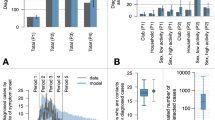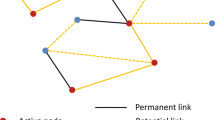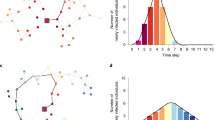Abstract
Distributions of the number of sexual partners reported in surveys show a pronounced skew, with most people having had one or no partners in the past year and a small fraction having had many1,2. Liljeros and colleagues3 infer from the results of a Swedish survey that there is a "scale-free" population distribution of sexual contacts, consistent with a preferential-attachment model3,4, in which “the rich get richer” and epidemics are driven by extremely promiscuous individuals. Here we reanalyse the data from Sweden and from other countries, using more appropriate statistical tools. Our findings support the conventional wisdom that epidemic thresholds exist in these populations, and indicate that current public-health strategies to reduce the spread of HIV and other sexually transmitted infections do not need to be radically refocused.
This is a preview of subscription content, access via your institution
Access options
Subscribe to this journal
Receive 51 print issues and online access
$199.00 per year
only $3.90 per issue
Buy this article
- Purchase on Springer Link
- Instant access to full article PDF
Prices may be subject to local taxes which are calculated during checkout

Similar content being viewed by others
References
Laumann, E. O., Gagnon, J. H., Michael, T. & Michaels, S. The Social Organization of Sexuality: Sexual Practices in the United States (Univ. Chicago Press, Chicago, 1994).
Lewin, B. (ed.) Sex in Sweden (Natl Inst. Pub. Health, Stockholm, 1996).
Liljeros, F., Edling, C. R., Amaral, L. A. N., Stanley, H. E. & Åberg, Y. Nature 411, 907–908 (2001).
Barabási, A. L. & Albert, R. Science 286, 509–512 (1999).
May, R. M. & Lloyd, A. L. Phys. Rev. E 64, 066112 (2001).
Johnson, N. L., Kotz, S. & Kemp, A. W. Univariate Discrete Distributions (Wiley, New York, 1992).
Anderson, R. M., Medley, G. F., May, R. M. & Johnson, A. M. IMA J. Math. Appl. Med. Biol. 3, 229–263 (1986).
Anderson, R. M. & May, R. M. Infectious Diseases of Humans: Dynamics and Control (Oxford Univ. Press, Oxford, 1991).
Jones, J. H. & Handcock, M. S. Proc. R. Soc. Lond. B published online (doi:10.1098/rspb.2003.2369).
Simon, H. Biometrika 42, 435–440 (1955).
Pastor-Satorras, R. & Vespignani, A. Phys. Rev. E 65, 035108 (2002).
Morris, M. & Kretzschmar, M. AIDS 11, 641–648 (1997).
Adimora, A. A. et al. Epidemiology 13, 320–327 (2002).
Author information
Authors and Affiliations
Corresponding author
Rights and permissions
About this article
Cite this article
Jones, J., Handcock, M. Sexual contacts and epidemic thresholds. Nature 423, 605–606 (2003). https://doi.org/10.1038/423605a
Issue Date:
DOI: https://doi.org/10.1038/423605a
This article is cited by
-
Modified Lomax model: a heavy-tailed distribution for fitting large-scale real-world complex networks
Social Network Analysis and Mining (2021)
-
Rare and everywhere: Perspectives on scale-free networks
Nature Communications (2019)
Comments
By submitting a comment you agree to abide by our Terms and Community Guidelines. If you find something abusive or that does not comply with our terms or guidelines please flag it as inappropriate.



